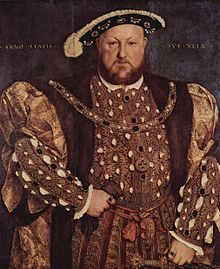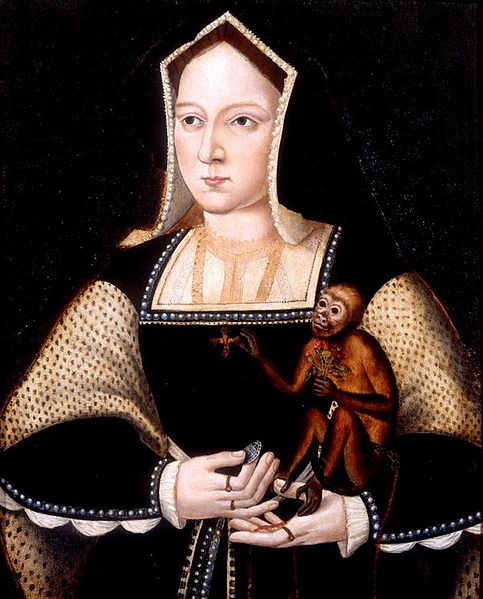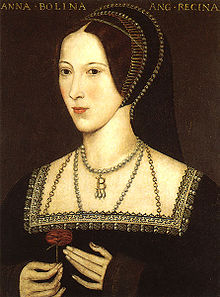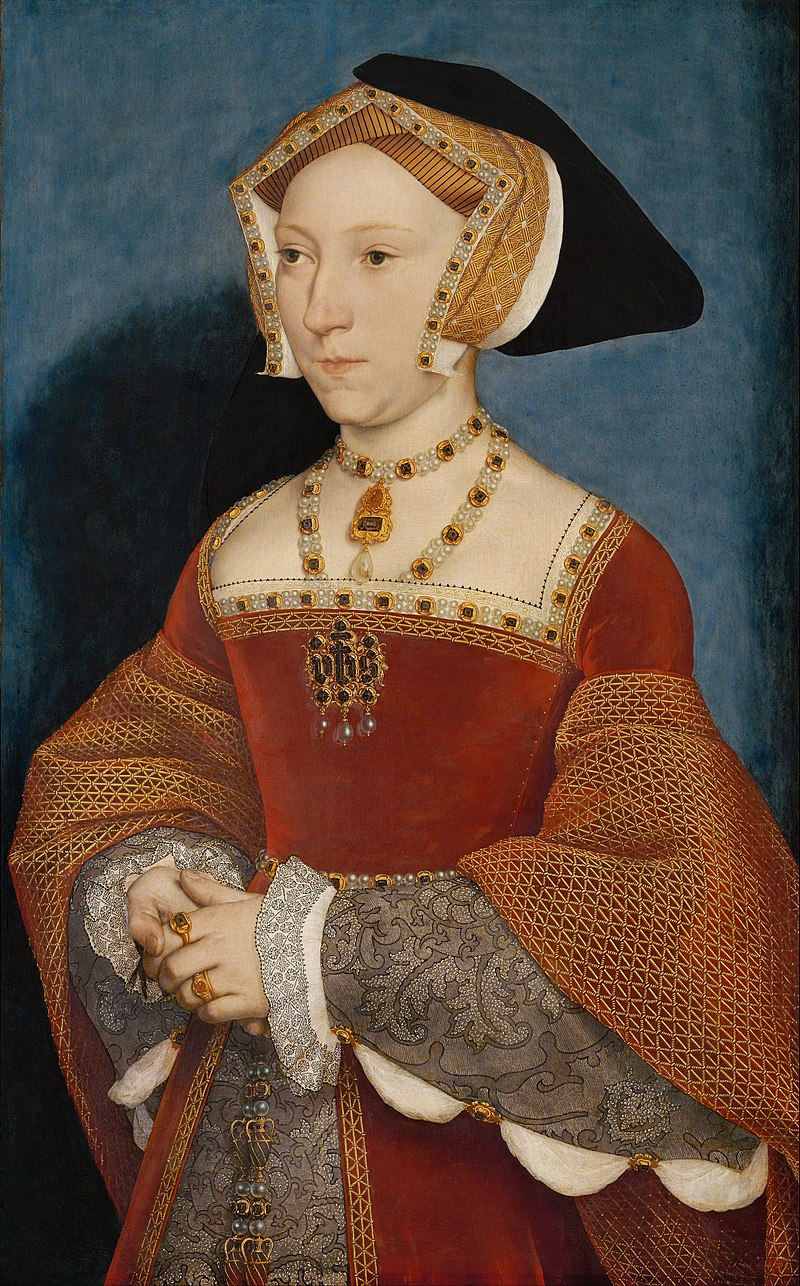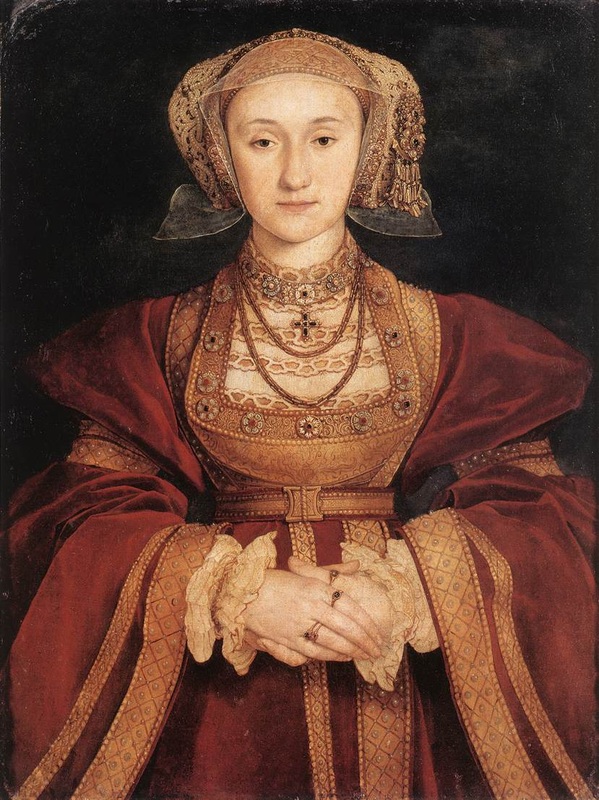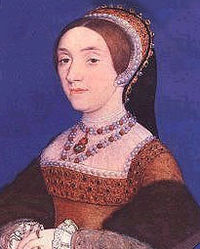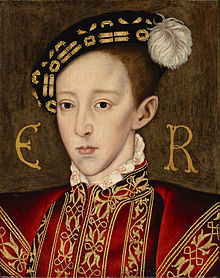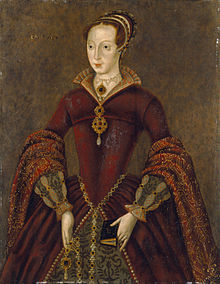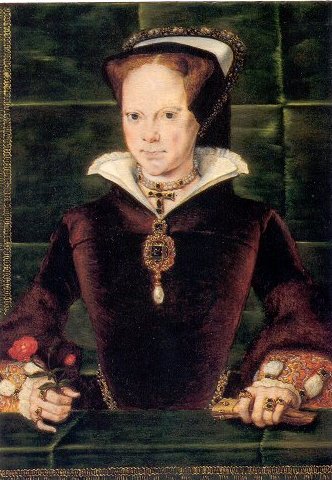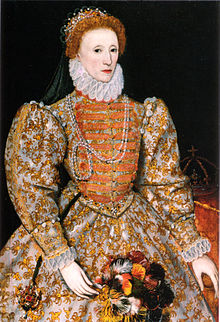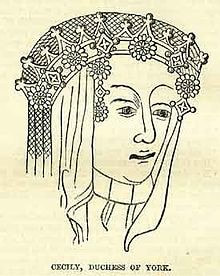 Cecily, Duchess of York, portrait by Edward Harding, 1792 (National Portrait Gallery, London).
Cecily, Duchess of York, portrait by Edward Harding, 1792 (National Portrait Gallery, London). As was often the case for medieval noblewomen, a significant proportion of Cecily’s life was defined by marriage, childbearing, military battles and, of course, the many bereavements that came with having multiple family members engaged in frequent conflict. This meant that many royal and aristocratic women developed a much deeper interest in religious practice after their husbands had died, perhaps because they needed to find something to occupy their time; it is also possible that widowhood was the first opportunity that women such as Cecily had to explore their interest in religion in greater depth. Cecily was particularly interested in the writings and religious order of St Bridget of Sweden, a fourteenth-century noblewoman whose many spiritual revelations, or visions from God, were collected into a lengthy book known as the Liber celestis. Bridget’s works were immensely popular in late medieval England, and it is possible that Cecily found Bridget’s visions particularly interesting because the two women shared a similar background. Like Cecily, Bridget was married at the age of fourteen, in 1316, and she gave birth to eight children. Having spent her married life raising children and managing a large, busy household, Bridget developed a profound interest in the religious life following her husband’s death, entering a Cistercian abbey and making a pilgrimage to Rome in 1350. It is possible, therefore, that Cecily saw something of herself in Bridget’s trajectory towards a more deeply pious life, and wanted to emulate it for herself.
 Raby Castle, Durham.
Raby Castle, Durham. When I first started working on Cecily and her fascination with the lives and reading of nuns, I wondered how she reconciled her own life of lavish luxury with the much more austere circumstances that medieval nuns were expected to embrace. It is impossible to say, of course, just how Cecily negotiated the significant conflict between her actual lifestyle and the one that she spent such a great deal of time imagining. The religious literature that Cecily most enjoyed reading does give us something of a clue, though, as to how she might have put her domestic circumstances to effective use in the service of her religious ambitions. Fifteenth-century religious literature was absolutely full of domestic images, metaphors and allegories, with spiritual writers drawing heavily on the imagery of the household in order to articulate often complex religious ideas. One aspect of religious life that late medieval women found especially appealing was the prospect of entering into ‘spiritual marriage’ with God. This meant that the woman would devote herself entirely to God, just as she would when taking her marriage vows, and imagine Jesus as her husband.
Bridget of Sweden’s visions of her own spiritual marriage with Jesus, which Cecily would probably have been very familiar with, draw heavily on the imagery of comfortable domestic circumstances. The second part of Bridget’s Liber celestis contains a fairly long allegory, in which the necessary religious values and virtues that make a successful spiritual marriage are reimagined in terms of the material goods that a literal newly married couple would need to buy for their household. In Bridget’s allegory, Jesus tells his prospective wife what she must stockpile in three different houses, the first of which should contain various different foods and drinks; these sustaining items all represent different Christian values and beliefs. The spiritual wife should make sure, for example, that the house contains bread, which symbolises ‘good will’, along with some salt to sprinkle on it, which represents God’s wisdom. The second house should contain various different types of cloth, including linen, which represents good and kind actions, as well as silk, which stands for rude, vain speech. In the third and final house, the spiritual wife is expected to gather various animals and farming tools, including an axe, which the couple should use to cut through any ‘weeds’, which represent the sin of pride, that grow around their household.
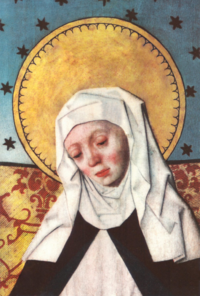 St Bridget of Sweden, altarpiece, Salem Church, Södermanland, Sweden.
St Bridget of Sweden, altarpiece, Salem Church, Södermanland, Sweden. Interestingly, Bridget of Sweden is by no means alone in suggesting that a life of material luxury could be an imaginative gateway to a deeper intimacy with God. One late medieval religious text that also seems to explore this idea is the Tretyse of Loue, a fifteenth-century English translation of an earlier French text, which was originally written with a female aristocratic reader in mind. The Tretyse is a guidance manual; this genre was enormously popular throughout the Middle Ages, especially with women, and its texts generally advised readers on how to practise their faith most effectively. At one point in the Tretyse, the anonymous author asks his reader to think about how her own luxurious domestic circumstances might help her to contemplate the altogether different living conditions of Mary, Joseph and Jesus:
'Now I pray yow, ryght dere sustyr, remembyr yow stedfastly whanne ye lye in your large softe bed, wel arayed wyth ryche clothys and warme couerynge and hote furrys, so well at ese, and your Ientylwoman so redy to serue yow, thanne thynke ye often wyth grete pyte how she that was the quene of angellys and Empresse of all þe worlde, how hyr bed was streyght and harde and arayed wyth pore clothys.'
Now, I am asking you, dear sister, always remember, when you are lying in your large, soft bed, beautifully adorned with lavish fabrics, warm blankets and cosy furs, lovely and comfortable, and with your serving lady so eager to serve you: think often, and with great pity, how she who was the queen of angels and empress of all the world [the Virgin Mary], had only a very hard, straight bed, which had hardly any blankets or coverings on it (translation mine).
What the author of the Tretyse is asking his reader to do, here, is fairly paradoxical: he wants her to use her luxurious domestic circumstances to think about the distance that this places between her and the Holy Family. This instruction would have given a reader like Cecily the opportunity to put her luxurious domestic circumstances to use in order to think more deeply about one of the most important aspects of the narrative of Jesus’ life on earth; the poverty of Jesus and his parents was always heavily emphasised by medieval religious writers. Far from being a barrier to her desire to mirror a nun’s approach to her faith, then, Cecily’s life of lavishness was often put to use by her favourite religious writers in order to help her achieve her spiritual ambitions. For the late medieval aristocratic woman, it wasn’t necessary to actually embark upon a life of austerity and deprivation, as nuns were expected to do. Instead, it was enough to simply think about material poverty, particularly that of the Holy Family, and to use your most beautiful cushions, furry blankets and embroidered bedclothes as props in your spiritual imaginings.
Armstrong, C. A. J., England, France and Burgundy in the Fifteenth Century (London: The Hambledon Press, 1983)
Bartlett, Anne C., and Thomas H. Bestul, ‘Introduction’, in Cultures of Piety: Medieval English Devotional Literature in Translation, ed. by Anne Clark Bartlett and Thomas H. Bestul (Ithaca: Cornell University Press, 1999), pp. 1-18
Laynesmith, J. L., Cecily Duchess of York (London: Bloomsbury Academic, 2017)
The Liber Celestis of St Bridget of Sweden, ed. by Roger Ellis, EETS O. S. 291 (Oxford: Oxford University Press, 1987)
The Tretyse of Loue, ed. by John H. Fisher, EETS O. S. 223 (London: Oxford University Press, 1951)
Hello Tudor Enthusiast readers! My name is Dr Louise Campion, and I graduated with my PhD in late medieval English Literature from the University of Warwick in January 2020. I wrote my doctoral thesis on the prevalence of domestic imagery in late medieval religious texts in Middle English and French; I argued that the literal household sphere was becoming increasingly culturally important in the fourteenth and fifteenth centuries, which would have made the language of domesticity all the more potent. Before I read for my doctorate, I studied for a Masters degree in medieval English Literature at the University of Oxford, alongside the Tudor Enthusiast herself! I am mainly interested in the religious writing of the later Middle Ages, texts written for and by women, and the translation of Latin texts into European languages, particularly English and French. I have recently completed a Postdoctoral Research Fellowship at the University of Warwick's Institute of Advanced Study, and I am putting the finishing touches on my first book, 'Cushions, Kitchens and Christ', which should be published in late 2021. I have also recently started work on my second book project, which looks at the portrayal of strangers in late medieval religious writing.
 RSS Feed
RSS Feed
